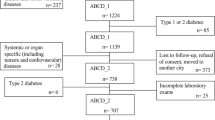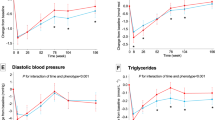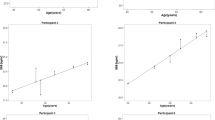Abstract
OBJECTIVE: To test whether a higher fasting insulin concentration is associated with a lower rate of weight gain over six to seven years.
DESIGN: Two longitudinal epidemiologic cohorts including blacks and whites.
SUBJECTS: The Coronary Artery Risk Development in Young Adults (CARDIA) Study examined subjects aged 18–30 y in 1985–86 and 1992–93 (n=3636), and the Atherosclerosis Risk in Communities (ARIC) Study examined subjects aged 45–64 y in 1987–89 and 1993–95 (n=11179).
MEASUREMENTS: In each study, fasting insulin at baseline and weight change during follow-up were measured in participants without diabetes.
RESULTS: In whites and black men in CARDIA, there was a positive age-adjusted association between baseline insulin and weight change, although weight change was not entirely monotonic across the insulin quartiles. In these race-gender-groups, the linear regression coefficients indicated that each 50 pmol/L increment of baseline insulin was associated (P<0.05) with approximately 0.10 kg/y greater rate of weight gain (95% confidence intervals (CI) for this estimate in kg/y were 0.023–0.187 for white women, 0.015–0.150 for black men, and 0.011–0.158 for white men). The association was eliminated entirely with adjustment for baseline weight. In contrast, among whites and black women in ARIC, the association was negative, with the linear regression coefficients suggesting that each 50 pmol/L higher fasting insulin concentration was associated (P<0.05) with a 0.03–0.10 kg/y lower rate of weight gain (95% CI for this estimate in kg/y were −0.133 to −0.061 for black women, −0.106 to −0.054 for white women, and −0.055 to −0.009 for white men). This finding was generally strengthened by adjustment for baseline body mass index (BMI).
CONCLUSIONS: A higher fasting insulin concentration is associated modestly with a lower rate of weight gain in ARIC, but not in CARDIA.
This is a preview of subscription content, access via your institution
Access options
Subscribe to this journal
Receive 12 print issues and online access
$259.00 per year
only $21.58 per issue
Buy this article
- Purchase on Springer Link
- Instant access to full article PDF
Prices may be subject to local taxes which are calculated during checkout
Similar content being viewed by others
Author information
Authors and Affiliations
Rights and permissions
About this article
Cite this article
Folsom, A., Vitelli, L., Lewis, C. et al. Is fasting insulin concentration inversely associated with rate of weight gain? Contrasting findings from the CARDIA and ARIC study cohorts. Int J Obes 22, 48–54 (1998). https://doi.org/10.1038/sj.ijo.0800542
Received:
Revised:
Accepted:
Published:
Issue Date:
DOI: https://doi.org/10.1038/sj.ijo.0800542
Keywords
This article is cited by
-
A longitudinal study of serum insulin and insulin resistance as predictors of weight and body fat gain in African American and Caucasian children
International Journal of Obesity (2017)
-
Insulin Resistance as a Predictor of Gains in Body Fat, Weight, and Abdominal Fat in Nondiabetic Women: A Prospective Study
Obesity (2012)
-
Insulin sensitivity at childhood predicts changes in total and central adiposity over a 6-year period
International Journal of Obesity (2011)
-
Prospective Investigation of Metabolic Characteristics in Relation to Weight Gain in Older Adults: The Hoorn Study
Obesity (2009)
-
Breast-feeding history and overweight in 11 to 13-year-old children in Iran
World Journal of Pediatrics (2009)



